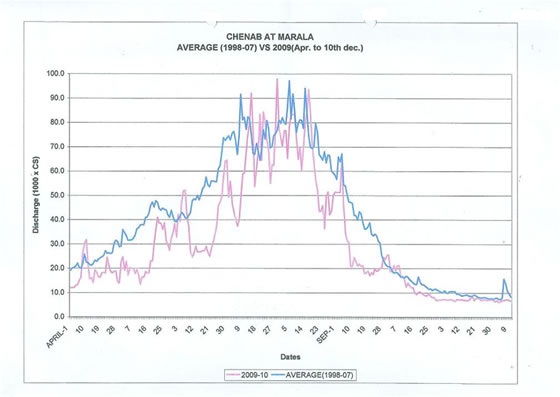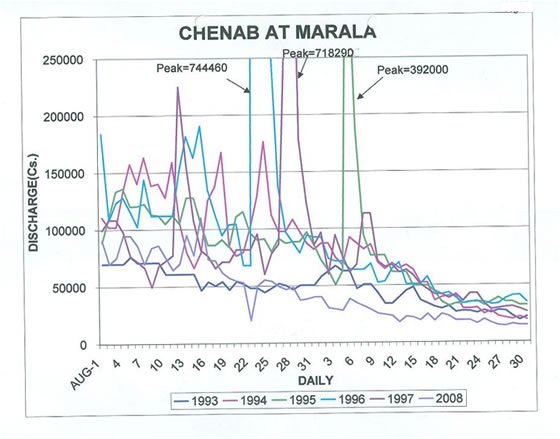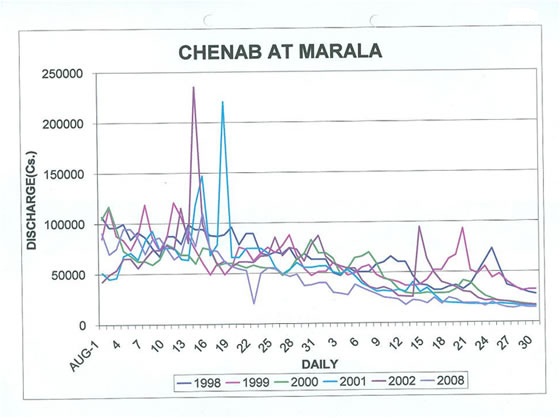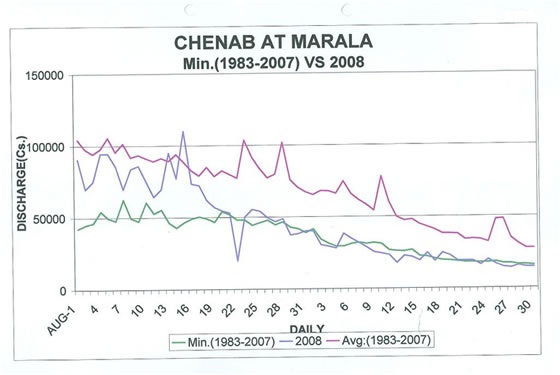AIDE MEMOIRE
AIDE MEMOIRE
Democratic India had used the “water weapon” (being upper riparian) in 1948 against
accepted norms of civilized behavior and international laws governing sharing of
waters by neighboring states. The first nation that sensed the gravity of the situation
was the USA and they had acted quickly. Several initiatives were also taken directly
by PAK officials to convince the Indians not to put into practice their threat “to starve Sindh & Punjab….. (and)…… would have to beg for every drop of water”.
As Mr. Bashir A. Malik writes in his book (Indus Waters Treaty in Retrospect) the
East Punjab government had made it clear that:
“(it) would not restore the flow
of water to the canals unless West Punjab acknowledged that it had no right to the
water”
. President Truman dispatched to the sub-continent Mr. David
Lilienthal American’s greatest Irrigation Specialist & a founding father of TVA.
He spent six months in India & Pakistan. The two passages of David Lilienthal’s
article of August 1951 as delivered by President World Bank (IBRD) with his letter
of 06 Sep 1951 to P .M. Mr. Liaqut Ali Khan duly re produced:
Quote:
“Why the flow of the Punjab’s lifeblood was so carelessly handled in the partition no one seems to know. Pakistan includes some of the most productive food-growing lands in the world in western Punjab (the Kipling country) and the Sind. But without water for irrigation this would be desert. 20,000,000 acres would dry up in a week, tens of millions would starve. No army, with bombs and shellfire, could devastate a land as thoroughly as Pakistan could be devastated by the simple expedient of India’s permanently shutting off the sources of water that keep the fields and the people of Pakistan alive”………
The report also stated,
“The partition gave the major part of the irrigation lands of the Punjab and Sind to Pakistan; but the headwaters of same of the largest irrigation canals that feed Pakistan were left with India or Kashmir. All the rivers upto which Pakistan depends for life originate in India or Kashmir. Two thirds of the entire water supply originates in Kashmir where the snow-fed Indus rises”. Unquote
On 19 Sep 1960 India maneuvered to take forever waters of the three Eastern rivers (Ravi, Sutlej & Beas). From their flow she had around 6MAF historical share under British rule but now she secured to take the full flow averaging 33MAF. Pakistan was under the false hope that having sacrificed three rivers the other three were now exclusively for her use. The flows of all three western rivers have reduced but Chenab’s flow has fallen sharply in the last 20 years. Four graphical charts are self-explanatory.
Indian statement that’s she only uses occupied Kashmir waters for “run of the river” power generation is false. she willing to let neutral experts of World Bank & other agencies to the inflows into all her infrastructure projects in Held Kashmir? Why is it that she needs storages for these “run of the river” projects? Even one day’s storage for power is enough. We only know what comes downstream (outflows). The withdrawals are her state secret. She has by 2008 build or was building 61 infrastructure projects in Occupied Kashmir. There are strong reports of tunneling as well. India admits that Kashmir projects will generate 28, 000MW. The Federation of Indian Commerce & Industry (FICCI) in its mission statement of 2009 declares amongst other provocations that “Leveraging Water Issue: Indus Valley Treaty is highly tilted in favor of Pakistan. India is sparing water even beyond its treaty obligations. Water is very serious issue for Pakistan and India channelizing water for irrigation and power can seriously pressurize Pakistan”. This is a recipe for the genocide of the Pakistani people and possibly lead to the disintegration of the Federation through serious provincial conflict, de-industrialization, famine and poverty. The region could become a nuclear flashpoint due to this Indian policy. International players must become aware of this crucial reality as well. Territory of Jammu & Kashmir is being used in deadly game against Pakistan’s existence. Certainly we were born from the same womb, and as such owe great ties to one another. Based on this Pakistan can offer India vast partnerships in economy and culture. This surreptitious undeclared war by India is leading to history’s greatest genocide. How many millions have already perished due to famine & disease can only be imagined. Let men & women of goodwill all over the world including India rise and be heard.
Engr. Suleman N. Khan / New Delhi
29 July 10
Appendix: Essay of John Briscoe + 4 charts of Chenab Flow.
War or peace on the Indus?
 Anyone foolish enough to write on war
or peace in the Indus needs to first banish a set of immediate suspicions. I am
neither Indian nor Pakistani. I am a South African who has worked on water issues
in the subcontinent for 35 years and who has lived in Bangladesh (in the 1970s)
and Delhi (in the 2000s). In 2006 I published, with fine Indian colleagues, an Oxford
University Press book titled India’s Water Economy: Facing a Turbulent Future and,
with fine Pakistani colleagues, one titled Pakistan’s Water Economy: Running Dry.
Anyone foolish enough to write on war
or peace in the Indus needs to first banish a set of immediate suspicions. I am
neither Indian nor Pakistani. I am a South African who has worked on water issues
in the subcontinent for 35 years and who has lived in Bangladesh (in the 1970s)
and Delhi (in the 2000s). In 2006 I published, with fine Indian colleagues, an Oxford
University Press book titled India’s Water Economy: Facing a Turbulent Future and,
with fine Pakistani colleagues, one titled Pakistan’s Water Economy: Running Dry.
I was the Senior Water Advisor for the World Bank who dealt with the appointment of the Neutral Expert on the Baglihar case. My last assignment at the World Bank (relevant, as described later) was as Country Director for Brazil. I am now a mere university professor, and speak in the name of no one but myself.
I have deep affection for the people of both India and Pakistan, and am dismayed by what I see as a looming train wreck on the Indus, with disastrous consequences for both countries. I will outline why there is no objective conflict of interests between the countries over the waters of the Indus Basin, make some observations of the need for a change in public discourse, and suggest how the drivers of the train can put on the brakes before it is too late.
Is there an inherent conflict between India and Pakistan?
The simple answer is no. The Indus Waters Treaty allocates the water of the three western rivers to Pakistan, but allows India to tap the considerable hydropower potential of the Chenab and Jhelum before the rivers enter Pakistan.
The qualification is that this use of hydropower is not to affect either the quantity of water reaching Pakistan or to interfere with the natural timing of those flows. Since hydropower does not consume water, the only issue is timing. And timing is a very big issue, because agriculture in the Pakistani plains depends not only on how much water comes, but that it comes in critical periods during the planting season. The reality is that India could tap virtually all of the available power without negatively affecting the timing of flows to which Pakistan is entitled.
Is the Indus Treaty a stable basis for cooperation?
If Pakistan and India had normal, trustful relations, there would be a mutually-verified monitoring process which would assure that there is no change in the flows going into Pakistan. (In an even more ideal world, India could increase low-flows during the critical planting season, with significant benefit to Pakistani farmers and with very small impacts on power generation in India.) Because the relationship was not normal when the treaty was negotiated, Pakistan would agree only if limitations on India’s capacity to manipulate the timing of flows was hardwired into the treaty. This was done by limiting the amount of “live storage” (the storage that matters for changing the timing of flows) in each and every hydropower dam that India would construct on the two rivers.
While this made sense given knowledge in 1960, over time it became clear that this restriction gave rise to a major problem. The physical restrictions meant that gates for flushing silt out of the dams could not be built, thus ensuring that any dam in India would rapidly fill with the silt pouring off the young Himalayas.
This was a critical issue at stake in the Baglihar case. Pakistan (reasonably) said that the gates being installed were in violation of the specifications of the treaty. India (equally reasonably) argued that it would be wrong to build a dam knowing it would soon fill with silt. The finding of the Neutral Expert was essentially a reinterpretation of the Treaty, saying that the physical limitations no longer made sense. While the finding was reasonable in the case of Baglihar, it left Pakistan without the mechanism – limited live storage – which was its only (albeit weak) protection against upstream manipulation of flows in India. This vulnerability was driven home when India chose to fill Baglihar exactly at the time when it would impose maximum harm on farmers in downstream Pakistan.
If Baglihar was the only dam being built by India on the Chenab and Jhelum, this would be a limited problem. But following Baglihar is a veritable caravan of Indian projects – Kishanganga, Sawalkot, Pakuldul, Bursar, Dal Huste, Gyspa… The cumulative live storage will be large, giving India an unquestioned capacity to have major impact on the timing of flows into Pakistan. (Using Baglihar as a reference, simple back-of-the-envelope calculations, suggest that once it has constructed all of the planned hydropower plants on the Chenab, India will have an ability to effect major damage on Pakistan. First, there is the one-time effect of filling the new dams. If done during the wet season this would have little effect on Pakistan. But if done during the critical low-flow period, there would be a large one-time effect (as was the case when India filled Baglihar). Second, there is the permanent threat which would be a consequence of substantial cumulative live storage which could store about one month's worth of low-season flow on the Chenab. If, God forbid, India so chose, it could use this cumulative live storage to impose major reductions on water availability in Pakistan during the critical planting season.
On "the water problem" from both sides of the border and the role of the press Living in Delhi and working in both India and Pakistan, I was struck by a paradox. One country was a vigorous democracy, the other a military regime. But whereas an important part of the Pakistani press regularly reported India's views on the water issue in an objective way, the Indian press never did the same. I never saw a report which gave Indian readers a factual description of the enormous vulnerability of Pakistan, of the way in which India had socked it to Pakistan when filling Baglihar. How could this be, I asked? Because, a journalist colleague in Delhi told me, "when it comes to Kashmir – and the Indus Treaty is considered an integral part of Kashmir -- the ministry of external affairs instructs newspapers on what they can and cannot say, and often tells them explicitly what it is they are to say."
This apparently remains the case. In the context of the recent talks between India and Pakistan I read, in Boston, the electronic reports on the disagreement about "the water issue" in The Times of India, The Hindustan Times, The Hindu, The Indian Express and The Economic Times.(Respectively, http://timesofindia.indiatimes.com/india/Water-Pakistans-diversionary-tactic-/articleshow/5609099.cms, http://beta.thehindu.com/news/national/article112388.ece, http://www.hindustantimes.com/News-Feed/india/River-waters-The-next-testing-ground/Article1-512190.aspx, http://www.indianexpress.com/news/Pak-heats-up-water-sharing/583733, http://economictimes.indiatimes.com/news/politics/nation/Pak-takes-water-route-to-attack-India/articleshow/5665516.cms.)
Taken together, these reports make astounding reading. Not only was the message the same in each case ("no real issue, just Pakistani shenanigans"), but the arguments were the same, the numbers were the same and the phrases were the same. And in all cases the source was "analysts" and "experts" -- in not one case was the reader informed that this was reporting an official position of the Government of India.
Equally depressing is my repeated experience – most recently at a major international meeting of strategic security institutions in Delhi – that even the most liberal and enlightened of Indian analysts (many of whom are friends who I greatly respect) seem constitutionally incapable of seeing the great vulnerability and legitimate concern of Pakistan (which is obvious and objective to an outsider).
A way forward
This is a very uneven playing field. The regional hegemon is the upper riparian
and has all the cards in its hands. This asymmetry means that it is India that is
driving the train, and that change must start in India. In my view, four things
need to be done.
First, there must be some courageous and open-minded Indians – in government or out – who will stand up and explain to the public why this is not just an issue for Pakistan, but why it is an existential issue for Pakistan.
Second, there must be leadership from the Government of India. Here I am struck
by the stark difference between the behaviour of India and that of its fellow BRIC
– Brazil, the regional hegemon in Latin America.
Brazil and Paraguay have a binding agreement on their rights and responsibilities
on the massive Itaipu Binacional Hydropower Project. The proceeds, which are of
enormous importance to small Paraguay, played a politicised, polemical anti-Brazilian
part in the recent presidential election in Paraguay. Similarly, Brazil's and Bolivia's
binding agreement on gas also became part of an anti-Brazil presidential campaign
theme.
The public and press in Brazil bayed for blood and insisted that Bolivia and Paraguay
be made to pay. So what did President Luis Inacio Lula da Silva do? "Look," he said
to his irate countrymen, "these are poor countries, and these are huge issues for
them. They are our brothers. Yes, we are in our legal rights to be harsh with them,
but we are going to show understanding and generosity, and so I am unilaterally
doubling (in the case of Paraguay) and tripling (in the case of Bolivia) the payments
we make to them. Brazil is a big country and a relatively rich one, so this will
do a lot for them and won't harm us much." India could, and should, in my view,
similarly make the effort to see it from its neighbour's point of view, and should
show the generosity of spirit which is an integral part of being a truly great power
and good neighbour.
Third, this should translate into an invitation to Pakistan to explore ways in which the principles of the Indus Waters Treaty could be respected, while providing a win for Pakistan (assurance on their flows) and a win for India (reducing the chronic legal uncertainty which vexes every Indian project on the Chenab or Jhelum). With good will there are multiple ways in which the treaty could be maintained but reinterpreted so that both countries could win.
Fourth, discussions on the Indus waters should be de-linked from both historic grievances and from the other Kashmir-related issues. Again, it is a sign of statesmanship, not weakness, to acknowledge the past and then move beyond it. This is personal for me, as someone of Irish origin. Conor Cruise O'Brien once remarked, "Santayana said that those who did not learn their history would be condemned to repeat it; in the case of Ireland we have learned our history so well that we are condemned to repeat it, again and again."
And finally, as a South African I am acutely aware that Nelson Mandela, after 27 years in prison, chose not to settle scores but to look forward and construct a better future, for all the people of his country and mine. Who will be the Indian Mandela who will do this – for the benefit of Pakistanis and Indians – on the Indus?
The writer is the Gordon McKay Professor of Environmental Engineering, Harvard University.



